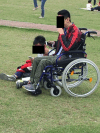Management and treatment of musculoskeletal problems in adults with cerebral palsy: Experience gained from two lifespan clinics
- PMID: 38552124
- PMCID: PMC10977450
- DOI: 10.3233/PRM-240018
Management and treatment of musculoskeletal problems in adults with cerebral palsy: Experience gained from two lifespan clinics
Keywords: Cerebral palsy; adults; musculoskeletal; orthopedic surgery.
Conflict of interest statement
Henry Chambers, MD, is a consultant for Abbvie Corporation. The other authors have no conflicts of interest.
Figures














Similar articles
-
Treatment of neuromuscular and musculoskeletal problems in cerebral palsy.Pediatr Rehabil. 2001 Jan-Mar;4(1):5-16. doi: 10.1080/13638490151068393. Pediatr Rehabil. 2001. PMID: 11330850 Review.
-
Secondary conditions of the musculoskeletal system in adolescents and adults with cerebral palsy.Phys Occup Ther Pediatr. 2001;21(4):49-68. doi: 10.1300/j006v21n04_04. Phys Occup Ther Pediatr. 2001. PMID: 12043172 Review.
-
Adults with cerebral palsy: a workshop to define the challenges of treating and preventing secondary musculoskeletal and neuromuscular complications in this rapidly growing population.Dev Med Child Neurol. 2009 Oct;51 Suppl 4:2-11. doi: 10.1111/j.1469-8749.2009.03462.x. Dev Med Child Neurol. 2009. PMID: 19740204
-
Pediatric Neuromuscular Disorders.Pediatr Clin North Am. 2020 Feb;67(1):45-57. doi: 10.1016/j.pcl.2019.09.002. Pediatr Clin North Am. 2020. PMID: 31779836 Review.
-
Cerebral palsy - beyond hip deformities.Pediatr Radiol. 2019 Nov;49(12):1587-1594. doi: 10.1007/s00247-019-04519-w. Epub 2019 Nov 4. Pediatr Radiol. 2019. PMID: 31686165 Review.
Cited by
-
Predictive Factors for Postoperative Outcomes of Cervical Spondylotic Myelopathy in Individuals With Cerebral Palsy.Global Spine J. 2025 May 2:21925682251337396. doi: 10.1177/21925682251337396. Online ahead of print. Global Spine J. 2025. PMID: 40315352 Free PMC article.
-
The Role of Immersive Virtual Reality Interventions in Pediatric Cerebral Palsy: A Systematic Review across Motor and Cognitive Domains.Brain Sci. 2024 May 12;14(5):490. doi: 10.3390/brainsci14050490. Brain Sci. 2024. PMID: 38790468 Free PMC article. Review.
References
MeSH terms
LinkOut - more resources
Full Text Sources
Medical

